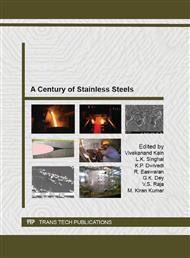p.645
p.670
p.681
p.691
p.697
p.705
p.714
p.731
p.741
Comparative Evaluation of 316L and N-Bearing Ni-Free Austenitic Stainless Steel as a Potential Cost-Effective Replacement for Body Implants
Abstract:
Currently austenitic stainless steels, cobalt-chromium alloys and titanium alloys are used in body implants. As per ISO 5832-1, Cr-Ni-Mo alloy 316L with minimum 13% nickel is widely used for body implants. ASTM standard F 2229-07 also permits nitrogen strengthened essentially Ni-free Cr-Mn-Mo alloy (UNS S 29108) for this purpose. Nitrogen as austenite stabilizer is able to substitute nickel. It serves the dual purpose of increasing the strength as well as pitting corrosion resistance. This paper compares the corrosion behaviour of these two grades. Cyclic potentiodynamic tests were carried as per ASTM F2129 in Simulated Body Fluids (SBFs) like Ringers, Hanks and Phosphaste Buffer Saline solution at 37 °C, which corresponds to the human body temperature. The pitting potential was significantly higher for Ni free grade S29108 as compared to 316L. In addition, re-passivation potential of the S 29108 was also far superior than 316L. The reverse scan indicated that the breakdown of the passive film was not reached in S 29108, whereas a hysteresis loop was observed in 316L. The strength of annealed S 29108 is far superior and meets the property requirement of ISO 5832-1 for 316L under cold rolled conditions. Thus this alloy could replace annealed as well as cold rolled 316L as per ISO 5832-1. This promising alloy has an added advantage of being significantly cheaper as compared to 316L and other Ti, Co based alloys to enable cost effective medical care to common man. Keywords: High nitrogen stainless steel, 316L, Bio-Implants, Potentio-dynamic tests.
Info:
Periodical:
Pages:
697-704
Citation:
Online since:
September 2013
Authors:
Price:
Сopyright:
© 2013 Trans Tech Publications Ltd. All Rights Reserved
Share:
Citation:


